One issue with WiFi that crops up regularly is that of selecting which channel to use. This is a subject on which several previous articles have been written, however the discovery of a 2004 paper by Cisco entitled 'Channel Deployment Issues for 2.4-GHz 802.11 WLANs', looks at whether or not it is possible to seat WiFi hotspots on neighbouring channels and the effect that channel separation has on performance. Though the paper is now nearly 10 years old, it remains one of the only references on the issue.
What the paper says, quite rightly, is that the extent to which a WiFi hotspot will cause interference to a neighbouring one is dependent on the extent to which interference from one is received by the other. This is partially a factor of the distance between them but is also related to their frequency separation. What the paper shows is that, in the USA, where there are 11 2.4 GHz WiFi channels available, only the set of channels 1, 6 and 11 are usable in such a way that a hotspot on one will not interfere with hotspots on the others. The paper examines what would happen if the set of channels 1, 4, 8 and 11 were used for four neighbouring hotspots. Cisco even did some tests which showed the following results:
| Channels Used | Throughput per Client |
|---|---|
| 1, 1, 6 and 11 | 601 KB/second |
| 1, 4, 8 and 11 | 349 KB/second |
What the results indicate is that even though, in the first test, two of the hotspots were on the same channel, the average throughput was increased over the four channel example because the overall level of interference was reduced. The paper also notes that WiFi hotspots on the same channel recognise each other and use various measures to try and avoid interfering whereas those on neighbouring channels just see interference on the channel. This is one reason why it is better to use a set group of channels in a given area (and to see what your neighbours are doing) rather than just pick a channel at random.
Having read this paper, the question that immediately arose was whether or not the fact that in Europe (and certain other parts of the world) there are 13 2.4 GHz WiFi channels available and not 11, offers up the possibility of a four channel arrangement that actually works - channels 1, 5, 9 and 13. The diagrams below show the emissions that are produced by the hotspots in the original three and proposed European four channel arrangements.
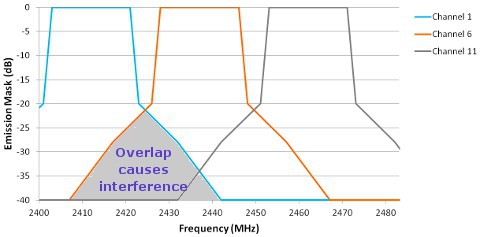
Three channel arrangement
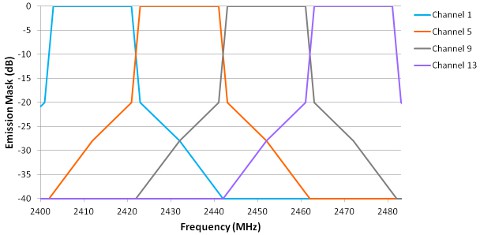
Four channel arrangement
The amount of interference that is caused between devices is the overlapping area of the emissions of one transmitter with that of the receiver of a device on another channel (shown shaded on the first diagram). Using the standard emission mask to represent the emissions from one device (in reality they are usually lower than this) and using the same mask to represent the characteristics of the receiver of another (again a reasonable assumption) the extent to which a transmission on one channel is received by a receiver on another channel can be easily calculated.
The chart below shows how much of the emissions of a transmitter on a given channel are received by a receiver which is offset by a certain amount from that channel.
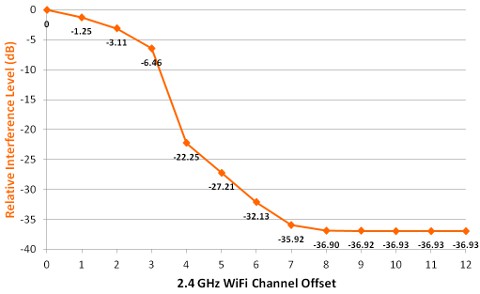
An offset of zero means that both are on the same channel and therefore the interference is at 100% (shown as 0 dB). When the transmitter and receiver are separated by one channel (eg one hotspot is on channel 6, the other on channel 7), the amount of interference that one causes the other reduces by 1.25 dB (representing around 75% of the original value). When this offset is increased to two channels (eg one hotspot on channel 5, the other on channel 7), the interference falls by 3.1 dB (or around 50%). At the extreme, when the offset reaches 8 channels or more, the interference has fallen by nearly 37 dB (or to around 0.02% of the original value). So...
- In the case of the use of channels 1, 6 and 11 where the offset is 5 channels it can be seen that the level of mutual interference between hotspots would be -27 dB (or around 0.2%).
- In the case of the use of channels 1, 5, 9 and 13 where the offset is 4 channels it can be seen that the level interference between hotspots would be -22 dB (or around 0.6%).
- In the case of the use of channels 1, 4, 8 and 11 where the offset falls to 3 channels, the level interference between hotspots rises dramatically -6.4 dB (or around 23%).
It is therefore, perhaps, no great surprise that using the four channel arrangement posed by Cisco that interference levels increased to the point that the throughput dropped by nearly half. It does, however, look feasible that in Europe the use of a four channel arrangement that uses channels 1, 5, 9 and 13 might be feasible. A lot will depend on the characteristics of the receivers in use and whether they are as good as the emission mask.
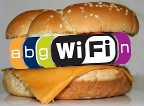 Don't worry if you haven't understood everything presented here, the salient points are:
Don't worry if you haven't understood everything presented here, the salient points are:
- In the USA and other places where there are only 11 WiFi channels available, throughput will be maximised if everyone in the same neighbo(u)rhood stuck to using only channels 1, 6 or 11.
- In Europe and other places where there are 13 WiFi channels available, it seems quite feasible that if everyone sticks to using channels 1, 5, 9 or 13, the performance of everyone's WiFi hotspots would be maximised.
- Using a WiFi hotspot on a channel which is offset from a nearby hotspot by 1, 2 or 3 channels is a recipe for both hotspots to suffer interference and have degraded performance.
- Randomly picking a channel for your WiFi hotspot (eg. setting it to your lucky number) is a recipe for poor performance all round.
It is perhaps worth noting that in the 5 GHz band, no such restrictions apply as, sensibly, all of the available channels are mutually independent from all the others!
Unfortunately, unlike Cisco, the Wireless Waffle team do not have a shed full of WiFi hotspots that can be used to do tests on throughput. Perhaps someone might like to take up this challenge and let us know what the results are?
add comment
( 4038 views )
| permalink
| 



 ( 2.7 / 3006 )
( 2.7 / 3006 )




 ( 2.7 / 3006 )
( 2.7 / 3006 )
Wireless Waffle received an e-mail from Des of Ireland. Des writes:
Take a look a the picture below (click on it to open a much larger version). It is a snapshot of the radio spectrum between roughly 6550 and 6950 kHz taken using the University of Twente's on-line receiver in the Netherlands (which is a marvel in itself). The snapshot was taken at about 07:00 GMT. The horizontal axis shows the frequency, the vertical axis is time (in thie case about a minute). Straight vertical lines represent constant transmissions. Dotted ones (such as the broken line just above 6600 kHz) are morse code. Other squiggles that are roughly vertical are all manner of other signals that can be found on the HF bands.

What is of interest here are the horizontal dashes of which there are three at the top left hand corner (just under 6550 kHz), four just below 6950 kHz and various others scattered across the chart, seemingly randomly (see around 6665 kHz and 6555 kHz for two bright ones). These are not bugs in the University's software, nor are they local interference in Twente. What they are are bursts of data from a frequency hopping transmitter. If you tune into one of the frequencies just at the time when the transmission is taking place on that frequency, you will hear a 'chuff' noise which is the quick burst of data that is being sent. If you happen across a frequency that has multiple 'hops' on it, the effect is not totally unlike there being a steam train on the frequency (listen to this actual recording).
At HF, this hopping transmission is almost certainly military in nature. Frequency hopping at HF is not at all uncommon. Even back in the 1980s, Racal's TRA 931XH would happily hop around the HF bands. In the case of the '931XH it did this by changing frequency roughly every second. Transmissions were just SSB (with an initial data burst to synchronise the receiver and transmitter - this is essential so that the two follow the same sequence of frequencies). The Wireless Waffle team had the fun of seeing a demo of the '931XH which was set to hop from frequencies between around 6950 and 7450 kHz, right across the 41m broadcast band. The effect of the hopping was to change the background noise every second or so - sometimes with a loud whistle caused by the carriers of the broadcast signals. The effect to anyone who happened to listen on a frequency that was being used would have been that they would have heard speech for a second which would then disappear.
 There's nothing unusual about the use of frequency hopping transmitters. Your bluetooth headset does this, and most GSM networks are set up to use frequency hopping too. The reason for using frequency hopping can be many and various, such as:
There's nothing unusual about the use of frequency hopping transmitters. Your bluetooth headset does this, and most GSM networks are set up to use frequency hopping too. The reason for using frequency hopping can be many and various, such as:
Since early May I have been noticing many many frequencies being occupied by very short bursts of digital 'noise' which are random in their frequency and time but very recognisable. So far pattern emerged is that they follow an 8 kHz spacing right across the HF bands (from 3.4 MHz to 28.5 MHz), but mainly in 6 to 9 MHz region. Even 6622kHz Shanwick being clobbered ... These noise bursts in the HF bands intrigue me, I wondered if it is a basic military comms set-up in case satellites/internet/microwave/fible-cable are clobbered.
Take a look a the picture below (click on it to open a much larger version). It is a snapshot of the radio spectrum between roughly 6550 and 6950 kHz taken using the University of Twente's on-line receiver in the Netherlands (which is a marvel in itself). The snapshot was taken at about 07:00 GMT. The horizontal axis shows the frequency, the vertical axis is time (in thie case about a minute). Straight vertical lines represent constant transmissions. Dotted ones (such as the broken line just above 6600 kHz) are morse code. Other squiggles that are roughly vertical are all manner of other signals that can be found on the HF bands.

What is of interest here are the horizontal dashes of which there are three at the top left hand corner (just under 6550 kHz), four just below 6950 kHz and various others scattered across the chart, seemingly randomly (see around 6665 kHz and 6555 kHz for two bright ones). These are not bugs in the University's software, nor are they local interference in Twente. What they are are bursts of data from a frequency hopping transmitter. If you tune into one of the frequencies just at the time when the transmission is taking place on that frequency, you will hear a 'chuff' noise which is the quick burst of data that is being sent. If you happen across a frequency that has multiple 'hops' on it, the effect is not totally unlike there being a steam train on the frequency (listen to this actual recording).
At HF, this hopping transmission is almost certainly military in nature. Frequency hopping at HF is not at all uncommon. Even back in the 1980s, Racal's TRA 931XH would happily hop around the HF bands. In the case of the '931XH it did this by changing frequency roughly every second. Transmissions were just SSB (with an initial data burst to synchronise the receiver and transmitter - this is essential so that the two follow the same sequence of frequencies). The Wireless Waffle team had the fun of seeing a demo of the '931XH which was set to hop from frequencies between around 6950 and 7450 kHz, right across the 41m broadcast band. The effect of the hopping was to change the background noise every second or so - sometimes with a loud whistle caused by the carriers of the broadcast signals. The effect to anyone who happened to listen on a frequency that was being used would have been that they would have heard speech for a second which would then disappear.
 There's nothing unusual about the use of frequency hopping transmitters. Your bluetooth headset does this, and most GSM networks are set up to use frequency hopping too. The reason for using frequency hopping can be many and various, such as:
There's nothing unusual about the use of frequency hopping transmitters. Your bluetooth headset does this, and most GSM networks are set up to use frequency hopping too. The reason for using frequency hopping can be many and various, such as:- Hopping around makes the transmission much more difficult to detect. Unless you know the sequence of frequencies being used, it's almost impossible to follow the transmission from one frequency to the next.
- Hopping can overcome some kinds of interference. If one frequency is blocked (from a broadcast transmission for example) the information sent on that frequency is lost, but if most are clear of interference, the error correction schemes can be arranged to deal with missing blocks and the overall communication is unaffected.
- Hopping can help overcome fading and propagation problems. In a GSM network for example, Rayleigh fading will cause some channels to have deep fades and others not. Hopping around makes sure that these 'dead' channels do not cause a total lack of communication.
Sunday 23 December, 2012, 23:02 - Radio Randomness, Satellites, Much Ado About Nothing
Posted by Administrator
It seems there are very few songs which touch on the topic of satellite communications unless you count:Posted by Administrator
- Sleeping Satellite by Tasmin Archer;
- Satellite by Lena (Germany's Eurovision winner in 2010); and
- Satellite by Oceanlab.
I'm just talking to a satellite,
Twenty thousand miles up in the sky each night
Taken from Electric Light Orchestra's Calling America.
There’s also:
I saw two shooting stars last night,
I wished on them but they were only satellites,
It's wrong to wish on space hardware.
I wish, I wish, I wish you'd care.
Taken from Kirsty Macoll's New England.
So it was nice to be alerted to a piece of work which is not only about satellites, but is very specifically endorsing the use of C-Band satellite services (3400 – 4200 MHz) over and above the use of Ku-Band (10700 – 12500 MHz) in sub-Saharan Africa where C-Band reception is more reliable than Ku-Band due to the fact that it deals with rain fading much better than Ku-Band does.
The song is by Cameroonian artist Wes. In it, he laments the loss of his Ku-band equipment, and the main thrust of the song is that he is short of some solder with which to complete the installation of his new C-Band parts. The video has him stood in front of his non-functional C-Band dish whilst his team try to dance their way into fixing the problem. Eventually they set off on a trek to try and get him some solder as the dancing, no matter how energetic, is clearly not working.
The only odd thing is that there is an Asian lady who, all the way through the song, keeps going on about her blasted spade. Still, it all adds to the ambiance.
The song is called ‘Soldery Song’, and you will need to watch the video whilst at the same time reading the lyrics below as it is quite hard to follow what he is saying due to his strong African English accent (the spade lady's incessant moaning about her spade is shown in brackets)...
SOLDERY SONG – WES
Soldery Song – Wes by jibou
(My Spade, where’s my spade?)
Soldery song: me need a solder
Me got me some parts, now it's me too,
Old part me chuck, and new me part, yeh?
Soldery song: me need me a soldery solder
Me got me some parts, now it's me too,
Old part me chuck, and me new part, yeh?
I throw a my Ku away, melt some solder, done my way
I throw a my Ku away, melt some solder, done my way
Bring us C-band way (with a spade?)
One-a-where they can go?
Hey, I meant to check.
(Spade, yeh, yeh, yeh, yeh!) x 2
Soldery song: hoo hoo hoo hoo hoo, me need a solder
Me got me some parts, now it's me too,
Old part me chuck and new me part, yeh?
I throw a my Ku away, melt some solder, done my way
I throw a my Ku away, melt some solder, done my way
Bring us C-band way (with a spade?)
One-a-where they can go?
Hey, I meant to check.
(Spade, yeh, yeh, yeh, yeh!) x 2
No more can I Ku, new me parts C-band
No more can I Ku, new me parts knackered!
No more can I Ku, new me parts C-band
No more can I Ku, new me parts knackered!
No more can I Ku, new me parts C-band
No more can I Ku, new me parts knackered!
I throw a my Ku away, melt some solder, done my way x 4
Bring us C-band way (with a spade?)
One-a-where they can go?
(Spade, yeh, yeh, yeh, yeh!)
Bring us C-band way (with a spade?)
One-a-where they can go?
Hey, I meant to check.
No more can I Ku, new me parts C-band
No more can I Ku, new me parts knackered!
No more can I Ku, new me parts C-band
No more can I Ku...
(Spade, yeh, yeh, yeh, yeh!)
Perhaps some kind Wireless Waffle reader could purchase some solder and send it to Wes to get his C-band equipment up and working. Oh, and whilst you’re at it, give the poor lady a spade too.
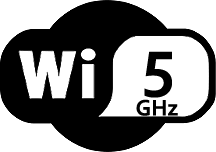 Although the standard for WiFi at 5 GHz has been around for a long time, most manufacturers have focused upon producing equipment for the 2.4 GHz band. The reason for this is a simple one - it's cheaper! The higher you go in frequency, the more difficult, and therefore expensive, it becomes to transmit and receive radio signals. As a result, home routers, laptops, smart phones and other devices have almost exclusively been equipped to use the 2.4 GHz band for their WiFi connection.
Although the standard for WiFi at 5 GHz has been around for a long time, most manufacturers have focused upon producing equipment for the 2.4 GHz band. The reason for this is a simple one - it's cheaper! The higher you go in frequency, the more difficult, and therefore expensive, it becomes to transmit and receive radio signals. As a result, home routers, laptops, smart phones and other devices have almost exclusively been equipped to use the 2.4 GHz band for their WiFi connection.Previous Wireless Waffle articles have discussed how to select the best WiFi channels in the 2.4 GHz band, and other techniques, to maximise coverage and signal quality, however we have not looked at the 5 GHz band. Recently, there seem to be a slew of articles which are claiming that using 5 GHz will produce better range and more reliable connections compared to 2.4 GHz. The logic of these articles seems to go '5 is a bigger number than 2.4 - in fact it is more than double - so it must be at least twice as good'. This, sad to say, is not the case. Here are the real facts:
- Signals at 5 GHz only travel HALF as far as those on 2.4 GHz as higher frequencies have poorer coverage than lower ones.
- Signals at 5 GHz will struggle almost TWICE AS HARD to get through walls than signals at 2.4 GHz due to their poorer propagation characteristics.
- 5 GHz WiFi equipment is subject to exactly the same POWER RESTRICTIONS as that for 2.4 GHz, so there is no inherent advantage in terms of the technology itself.
- The use of some of the 5 GHz channels is subject to the requirement to STOP TRANSMITTING if a nearby radar is detected. No such restriction applies at 2.4 GHz.
- 5 GHz equipment will be (slightly) more POWER HUNGRY than its 2.4 GHz counterparts, increasing battery drain especially in mobile devices.
- 5 GHz receivers are likely to be LESS SENSITIVE than 2.4 GHz receivers because of the increased difficulty of making low noise devices at higher frequencies.
- The 5 GHz band consists of up to 25 (territory dependent) independent channels which can be used without interfering with each other meaning there is much GREATER CAPACITY for more networks, whereas the 2.4 GHz band has 13 channels of which only 3 can be used independently.
- The 2.4 GHz band is also used for Bluetooth, microwave ovens, wireless cameras and many other applications meaning it can be subject to a lot of background interference. The 5 GHz band is MUCH CLEANER, though the band is not exclusive to WiFi systems.
- There are still fewer 5 GHz devices around than 2.4 GHz once and hence it is likely to be LESS SUSCEPTIBLE TO SNOOPING.
For a home network, in a small house or apartment, using 5 GHz may offer some advantages given the lower interference it will suffer from other devices, but in large family homes a 5 GHz WiFi router is unlikely to be able to outperform the coverage and range that a 2.4 GHz router achieves.
 Where the 5 GHz band may come into its own is when the not-quite-yet-finalised IEEE 802.11ac standard is adopted. This works in the 5 GHz bands and uses the greater capacity of the band to deliver connection speeds of up to 1 Gbps. For streaming media around, this has clear advantages. As a wireless distribution for a home internet connection, however, there is unlikely to be any improvement noticeable using 802.11ac than with the existing 802.11n standard which can already offer connections of over 100 Mbps - much faster than most home internet connections!
Where the 5 GHz band may come into its own is when the not-quite-yet-finalised IEEE 802.11ac standard is adopted. This works in the 5 GHz bands and uses the greater capacity of the band to deliver connection speeds of up to 1 Gbps. For streaming media around, this has clear advantages. As a wireless distribution for a home internet connection, however, there is unlikely to be any improvement noticeable using 802.11ac than with the existing 802.11n standard which can already offer connections of over 100 Mbps - much faster than most home internet connections!
